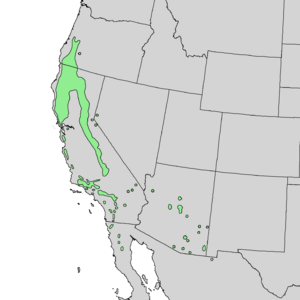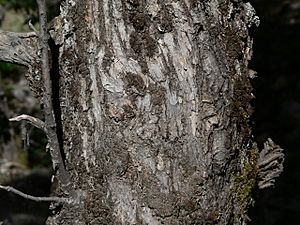Quercus chrysolepis facts for kids
Quick facts for kids Quercus chrysolepis |
|
|---|---|
 |
|
| Leaves and acorns | |
| Conservation status | |
| Scientific classification | |
| Genus: |
Quercus
|
| Species: |
chrysolepis
|
 |
|
| Natural range of Quercus chrysolepis | |
| Synonyms | |
|
|
The Quercus chrysolepis, also known as the canyon live oak or golden cup oak, is a type of evergreen oak tree. This means it keeps its leaves all year round. You can find it in Mexico and the western parts of the United States, especially in places like the California Coast Ranges.
This tree often grows near creeks and wet areas, where it can find cool, moist spots. Its leaves are shiny and dark green on top, with sharp spines along the edges. A cool fact about these leaves is that they are usually very flat. Canyon live oaks often grow alongside other oak species, like the California live oak. Long ago, fossils show that this tree used to grow in many more places across the western United States.
Native Americans used the acorns from this tree as a main food source. They would first clean out the bitter parts (called tannins). The roasted seeds could even be used to make a coffee-like drink! After forest fires, the canyon live oak grows back very strongly from its base.
Contents
What Does the Canyon Live Oak Look Like?
The Quercus chrysolepis is an evergreen tree with wide, spreading branches and a round top. It can grow to be about 6 to 30 meters (20 to 100 feet) tall. Sometimes, it grows more like a large bush. The main trunk can be 30 to 100 centimeters (1 to 3 feet) wide. Some very large canyon live oaks are found in the mountains of Southern California. One of the biggest known trees in the San Bernardino Mountains is 124 feet tall!
Its leaves are shaped like an oval, usually 2.5 to 8 centimeters (1 to 3.2 inches) long. They are about half as wide as they are long. The leaves are pointed at the tip but rounded at the bottom. While they look flat, their edges might curl under a little. They often have spiny teeth, especially on younger branches. These leaves feel leathery and are a shiny dark green on top. The underside is a dull golden color, which often turns gray as the leaf gets older.
The bark of the canyon live oak is light gray. It can be smooth or a bit scaly. The acorns grow alone or in pairs. They are usually 2 to 5 centimeters (about 1 to 2 inches) long. Their size and shape can vary, but they are generally oval and look a bit like a turban. The cup that holds the acorn is thick and covered with yellowish hairs. The stem connecting the acorn to the branch is very short.
Where Does the Canyon Live Oak Grow?
You can find Quercus chrysolepis in many different forests in the southwestern United States. It is common in the mountains of California, like the Sierra Nevada and Pacific Coast Ranges. You can also find it in parts of southwestern Oregon, western Nevada, northern Baja California (in Mexico), Arizona, southwestern New Mexico, and Chihuahua.
The canyon live oak can grow in many types of soil, even very rocky ones. It can handle cold temperatures down to about -11 °F. It prefers soils that are neutral to slightly acidic. For example, it grows well in the rocky, unique soils of the Cedars in Sonoma County, California.
This tree grows at different heights depending on the area. In southwestern Oregon, it's found from about 500 to 1500 meters high. In Northern California, it grows from 100 to 1400 meters. In Southern California, it can be found as high as 2700 meters. The canyon live oak can be the main tree on steep canyon walls, especially where the soil is shallow and rocky. In places with a lot of rain, it grows on south-facing slopes. In hotter, drier areas, it grows on north-facing slopes, where it's cooler.
How Does the Canyon Live Oak Interact with Nature?
Besides being a food source for humans long ago, the acorns of canyon live oaks are eaten by many different wildlife animals. These include acorn woodpeckers, California ground squirrels, dusky-footed wood rats, western harvest mouses, and black-tailed deer. It seems that animals don't really prefer acorns from one oak species over another.
The canyon live oak can mix its genes with other oak species that grow nearby. This is called hybridization, and it happens more with this oak than almost any other oak species. Scientists have studied how well Quercus chrysolepis competes with other trees. They found that in places with low light, the canyon live oak does better than trees with bigger leaves. This is because its leaves are very good at making food from sunlight, and they last a long time.
Canyon live oaks provide a home for many animals. Birds use them for perching, nesting, and resting. Many other mammals find shade and cover under their branches. Young canyon live oaks are also a good food source for animals that browse, like deer. Canyon live oak forests are great places for mountain lions to live because there are often many deer there. Many animals eat the leaves of the canyon live oak, including black-tailed jackrabbits, beavers, brush rabbits, red-backed voles, Sonoma chipmunks, cactus mice, deer mice, and porcupines. Pocket gophers sometimes eat the inner bark of young canyon live oaks.
In southern California, a small moth called Neocrania bifasciata uses Quercus chrysolepis as its food plant.
Pollen and Allergies
The pollen from the canyon live oak can cause strong allergies in some people. This tree releases its pollen in the spring.
See also
 In Spanish: Encina mexicana azul para niños
In Spanish: Encina mexicana azul para niños



